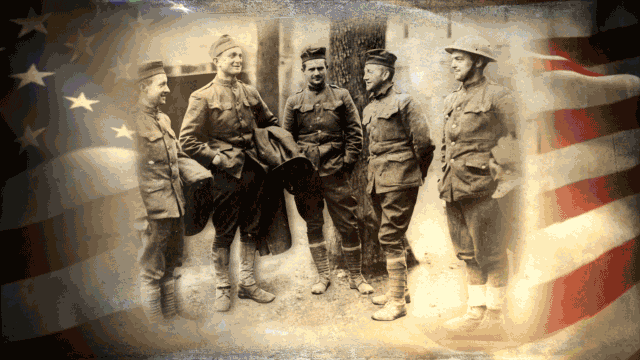
A poster depicting African-American soldiers in an Army stevedore company working on the docks of the French port of St. Nazaire. (National WWI Museum and Memorial)
The armistice that came into effect at 11 a.m. local time on Nov. 11, 1918, silenced the guns of World War I, ending one of the bloodiest conflicts in modern history.
More than 17 million people, military and civilian, lost their lives in World War I. The U.S, which entered the war on April 6, 1917, lost more than 116,000 service members in the conflict.
The National World War I Museum and Memorial in Kansas City, Missouri, is dedicated to sharing the stories and honoring the history of the devastating conflict, dubbed “the Great War.”
THIS BULLET-SCARRED BIBLE ‘SAVED THE LIFE’ OF A WORLD WAR I SOLDIER
Jonathan Casey, director of archives in the Museum’s Edward Jones Research Center, told Fox News that posters related to the war effort can offer a fascinating glimpse into a tumultuous era that changed the course of world history. “Posters are one of the best historical objects to tell the story of any time period,” he explained, noting that the Museum has around 1,200 posters in its collection. “They are very engaging,” he added.

A World War I U.S. Army recruitment poster (National WWI Museum and Memorial)
In addition to U.S. posters, most of which are devoted to recruitment and war financing, the Museum also has posters from a host of other countries including Germany, the Austro-Hungarian Empire and Russia. “Each one represents its own culture,” Casey said.

Among the U.S. posters, Casey highlights one in particular that depicts African-American soldiers working in an Army stevedore company in the French port of St. Nazaire. The poster, which is pictured above, is the only one in the Museum’s collection depicting African-American troops.
AMERICA'S DEADLIEST BATTLE: WORLD WAR I'S MEUSE-ARGONNE OFFENSIVE 100 YEARS LATER
Painted by a U.S. officer, the poster was printed in Nantes, France, as an apparent morale booster for troops. “There was a competition about how much supplies could be unloaded from the ships,” Casey explained. “This poster was done in recognition of their work – it may have been an African-American company that won this competition.”

World War I Red Cross poster. (National WWI Museum and Memorial)
Measuring about 2-and-a-half feet by 3 feet, the poster is signed and dedicated by the artist, dated Nov. 28, 1918. “This was a donation [to the Museum] from a man whose father was an officer in the war, in the Quartermasters’ Corps,” Casey said.
INCREDIBLE WORLD WAR I DIARY SURFACES
One German military poster is a particular source of fascination. Written in Gothic-style script, the poster, pictured below, it advertises an unusual event in the French town of Malmedy, which was occupied at the time by German forces.

The poster advertising an art exhibition in German-occupied France during the final weeks of World War I. (National WWI Museum and Memorial)
Created by the German Army’s Gallwitz division, the whimsical poster features a cherubic child, bearing a German helmet filled with flowers. The poster promotes an art exhibition in October 1918, just weeks before the end of the war. The division was part of the German forces opposing the Meuse-Argonne Offensive, which was launched by U.S. forces on Sept. 26, 2018. The 46-day clash claimed the lives of 26,277 U.S. troops and ranks as the deadliest battle in U.S. history.
“That one came folded up in a photo album from someone whose father was a doctor with U.S. forces,” Casey said, adding that he was surprised when he saw the poster. “I didn’t understand why they made a poster to advertise an art show in the middle of this huge war.”
100-YEAR OLD LETTER FROM WWI UNCOVERED
Officials at the Kansas City site are hosting a number of events to commemorate the 100th anniversary of World War I’s end. These include a nightly “Peace and Remembrance” illumination of the memorial that features nearly 55 million pixels and more than 5,000 poppies. Inspired by the First World War poem “In Flanders Field,” artificial red poppies are worn in a number of countries to remember the millions that lost their lives in the conflict.

A World War I promoting Liberty Bonds that were sold to support the U.S. war effort. (National WWI Museum and Memorial)
On Sunday, a multi-national Armistice Ceremony will honor the centennial of the World War I Armistice. A 'Bells of Peace' tolling ceremony will also commemorate the time of the signing of the Armistice.
Fox News’ Greg Norman contributed to this article. Follow James Rogers on Twitter @jamesjrogers